CHEVROLET TRAVERSE 2009 1.G Owners Manual
Manufacturer: CHEVROLET, Model Year: 2009, Model line: TRAVERSE, Model: CHEVROLET TRAVERSE 2009 1.GPages: 422, PDF Size: 2.06 MB
Page 1 of 422
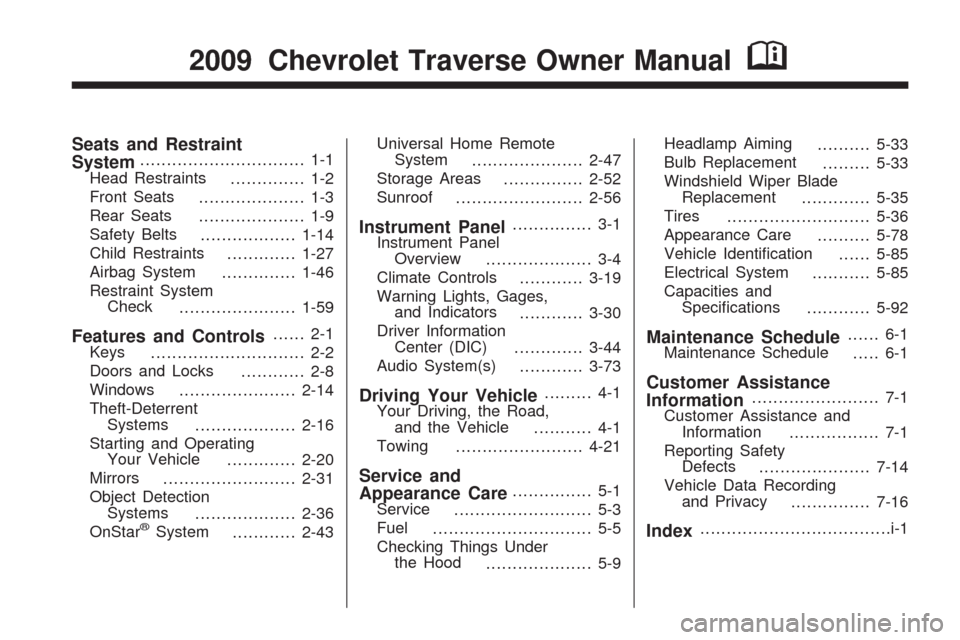
Seats and Restraint
System............................... 1-1
Head Restraints
.............. 1-2
Front Seats
.................... 1-3
Rear Seats
.................... 1-9
Safety Belts
..................1-14
Child Restraints
.............1-27
Airbag System
..............1-46
Restraint System
Check
......................1-59
Features and Controls...... 2-1
Keys
............................. 2-2
Doors and Locks
............ 2-8
Windows
......................2-14
Theft-Deterrent
Systems
...................2-16
Starting and Operating
Your Vehicle
.............2-20
Mirrors
.........................2-31
Object Detection
Systems
...................2-36
OnStar
®System
............2-43Universal Home Remote
System
.....................2-47
Storage Areas
...............2-52
Sunroof
........................2-56
Instrument Panel............... 3-1
Instrument Panel
Overview
.................... 3-4
Climate Controls
............3-19
Warning Lights, Gages,
and Indicators
............3-30
Driver Information
Center (DIC)
.............3-44
Audio System(s)
............3-73
Driving Your Vehicle......... 4-1
Your Driving, the Road,
and the Vehicle
........... 4-1
Towing
........................4-21
Service and
Appearance Care............... 5-1
Service
.......................... 5-3
Fuel
.............................. 5-5
Checking Things Under
the Hood
.................... 5-9Headlamp Aiming
..........5-33
Bulb Replacement
.........5-33
Windshield Wiper Blade
Replacement
.............5-35
Tires
...........................5-36
Appearance Care
..........5-78
Vehicle Identi�cation
......5-85
Electrical System
...........5-85
Capacities and
Speci�cations
............5-92
Maintenance Schedule...... 6-1
Maintenance Schedule
..... 6-1
Customer Assistance
Information........................ 7-1
Customer Assistance and
Information
................. 7-1
Reporting Safety
Defects
.....................7-14
Vehicle Data Recording
and Privacy
...............7-16
Index....................................i-1
2009 Chevrolet Traverse Owner ManualM
Page 2 of 422
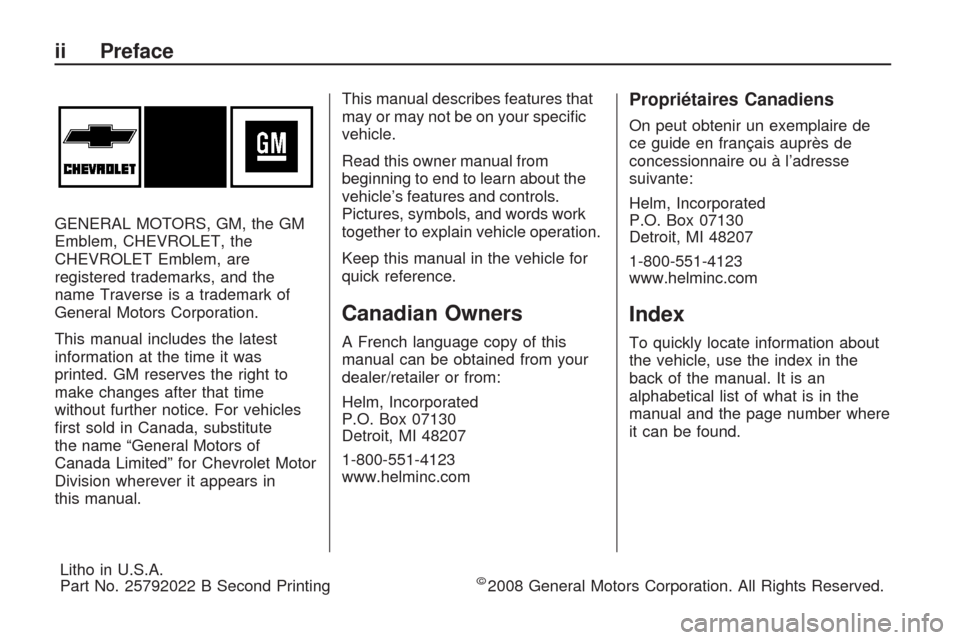
GENERAL MOTORS, GM, the GM
Emblem, CHEVROLET, the
CHEVROLET Emblem, are
registered trademarks, and the
name Traverse is a trademark of
General Motors Corporation.
This manual includes the latest
information at the time it was
printed. GM reserves the right to
make changes after that time
without further notice. For vehicles
�rst sold in Canada, substitute
the name “General Motors of
Canada Limited” for Chevrolet Motor
Division wherever it appears in
this manual.This manual describes features that
may or may not be on your speci�c
vehicle.
Read this owner manual from
beginning to end to learn about the
vehicle’s features and controls.
Pictures, symbols, and words work
together to explain vehicle operation.
Keep this manual in the vehicle for
quick reference.
Canadian Owners
A French language copy of this
manual can be obtained from your
dealer/retailer or from:
Helm, Incorporated
P.O. Box 07130
Detroit, MI 48207
1-800-551-4123
www.helminc.com
Propriétaires Canadiens
On peut obtenir un exemplaire de
ce guide en français auprès de
concessionnaire ou à l’adresse
suivante:
Helm, Incorporated
P.O. Box 07130
Detroit, MI 48207
1-800-551-4123
www.helminc.com
Index
To quickly locate information about
the vehicle, use the index in the
back of the manual. It is an
alphabetical list of what is in the
manual and the page number where
it can be found.
ii Preface
Litho in U.S.A.
Part No. 25792022 B Second Printing©2008 General Motors Corporation. All Rights Reserved.
Page 3 of 422
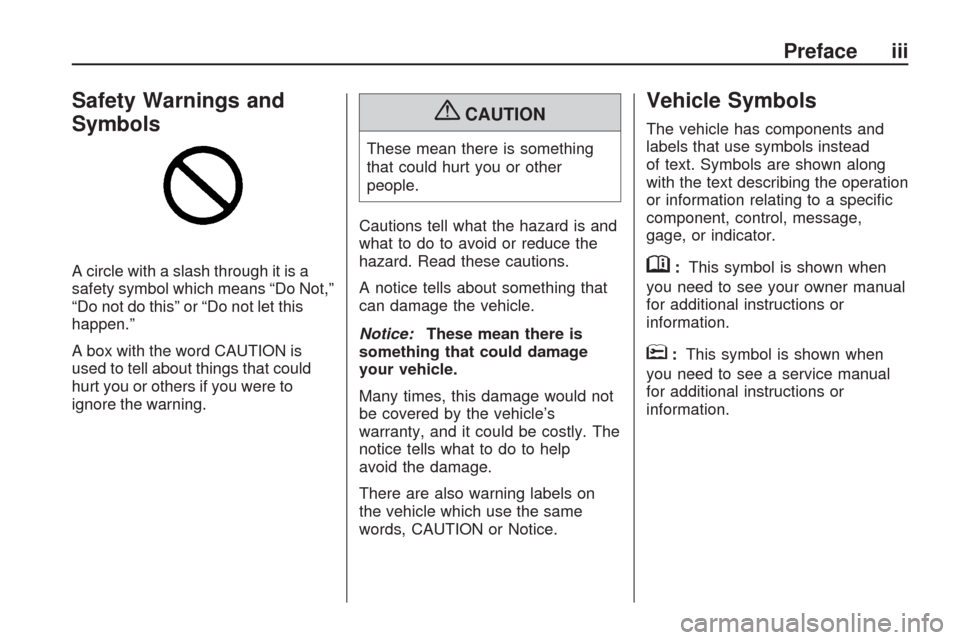
Safety Warnings and
Symbols
A circle with a slash through it is a
safety symbol which means “Do Not,”
“Do not do this” or “Do not let this
happen.”
A box with the word CAUTION is
used to tell about things that could
hurt you or others if you were to
ignore the warning.
{CAUTION
These mean there is something
that could hurt you or other
people.
Cautions tell what the hazard is and
what to do to avoid or reduce the
hazard. Read these cautions.
A notice tells about something that
can damage the vehicle.
Notice:These mean there is
something that could damage
your vehicle.
Many times, this damage would not
be covered by the vehicle’s
warranty, and it could be costly. The
notice tells what to do to help
avoid the damage.
There are also warning labels on
the vehicle which use the same
words, CAUTION or Notice.
Vehicle Symbols
The vehicle has components and
labels that use symbols instead
of text. Symbols are shown along
with the text describing the operation
or information relating to a speci�c
component, control, message,
gage, or indicator.
M:This symbol is shown when
you need to see your owner manual
for additional instructions or
information.
*:This symbol is shown when
you need to see a service manual
for additional instructions or
information.
Preface iii
Page 4 of 422

Vehicle Symbol Chart
Here are some additional symbols
that may be found on the vehicle
and what they mean. For more
information on the symbol, refer to
the index.
9:Airbag Readiness Light
#:Air Conditioning
!:Antilock Brake System (ABS)
g:Audio Steering Wheel
Controls or OnStar®
$:Brake System Warning Light
":Charging System
I:Cruise Control
B:Engine Coolant Temperature
O:Exterior Lamps
#:Fog Lamps
.:Fuel Gage
+:Fuses
i:Headlamp High/Low-Beam
Changer
j:LATCH System Child Restraints
*:Malfunction Indicator Lamp
::Oil Pressure
g:Outside Power Foldaway
Mirrors
}:Power
/:Remote Vehicle Start
>:Safety Belt Reminders
7:Tire Pressure Monitor
_:Tow/Haul Mode
F:Traction Control
M:Windshield Washer Fluid
iv Preface
Page 5 of 422
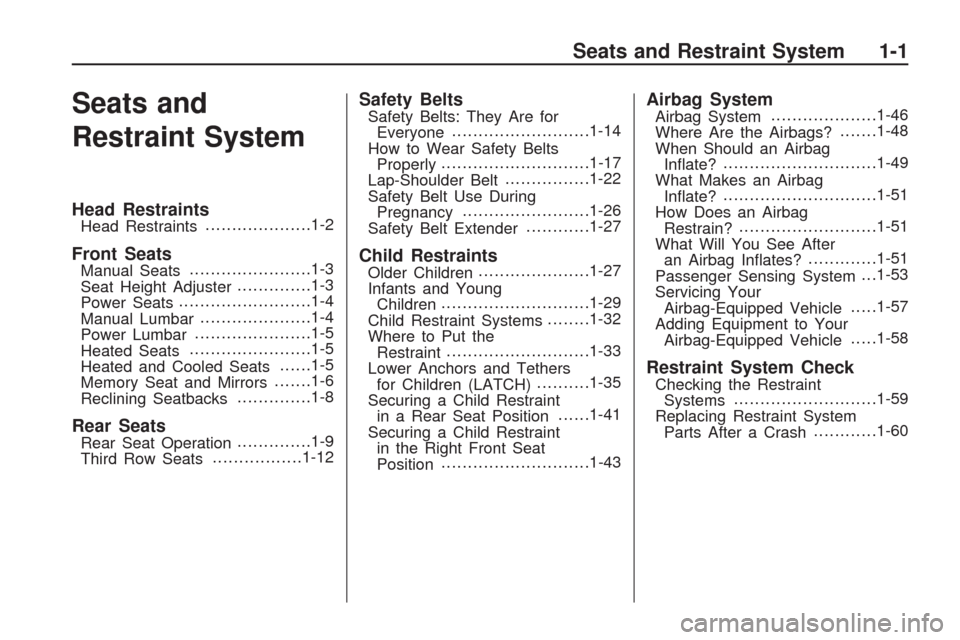
Seats and
Restraint System
Head RestraintsHead Restraints....................1-2
Front SeatsManual Seats.......................1-3
Seat Height Adjuster..............1-3
Power Seats.........................1-4
Manual Lumbar.....................1-4
Power Lumbar......................1-5
Heated Seats.......................1-5
Heated and Cooled Seats......1-5
Memory Seat and Mirrors.......1-6
Reclining Seatbacks..............1-8
Rear SeatsRear Seat Operation..............1-9
Third Row Seats.................1-12
Safety BeltsSafety Belts: They Are for
Everyone..........................1-14
How to Wear Safety Belts
Properly............................1-17
Lap-Shoulder Belt................1-22
Safety Belt Use During
Pregnancy........................1-26
Safety Belt Extender............1-27
Child RestraintsOlder Children.....................1-27
Infants and Young
Children............................1-29
Child Restraint Systems........1-32
Where to Put the
Restraint...........................1-33
Lower Anchors and Tethers
for Children (LATCH)..........1-35
Securing a Child Restraint
in a Rear Seat Position......1-41
Securing a Child Restraint
in the Right Front Seat
Position............................1-43
Airbag SystemAirbag System....................1-46
Where Are the Airbags?.......1-48
When Should an Airbag
In�ate?.............................1-49
What Makes an Airbag
In�ate?.............................1-51
How Does an Airbag
Restrain?..........................1-51
What Will You See After
an Airbag In�ates?.............1-51
Passenger Sensing System. . .1-53
Servicing Your
Airbag-Equipped Vehicle.....1-57
Adding Equipment to Your
Airbag-Equipped Vehicle.....1-58
Restraint System CheckChecking the Restraint
Systems...........................1-59
Replacing Restraint System
Parts After a Crash............1-60
Seats and Restraint System 1-1
Page 6 of 422
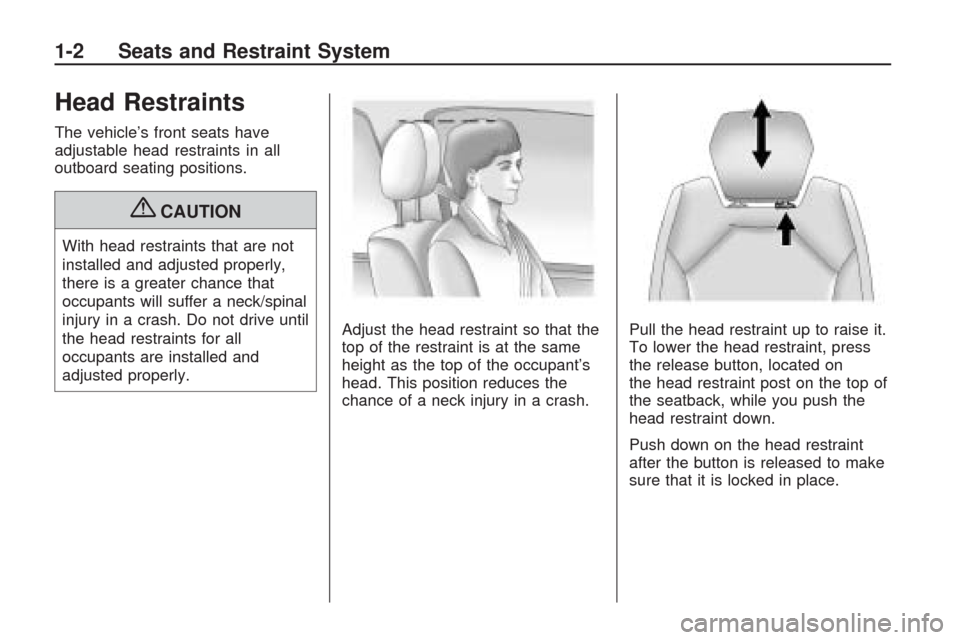
Head Restraints
The vehicle’s front seats have
adjustable head restraints in all
outboard seating positions.
{CAUTION
With head restraints that are not
installed and adjusted properly,
there is a greater chance that
occupants will suffer a neck/spinal
injury in a crash. Do not drive until
the head restraints for all
occupants are installed and
adjusted properly.Adjust the head restraint so that the
top of the restraint is at the same
height as the top of the occupant’s
head. This position reduces the
chance of a neck injury in a crash.Pull the head restraint up to raise it.
To lower the head restraint, press
the release button, located on
the head restraint post on the top of
the seatback, while you push the
head restraint down.
Push down on the head restraint
after the button is released to make
sure that it is locked in place.
1-2 Seats and Restraint System
Page 7 of 422
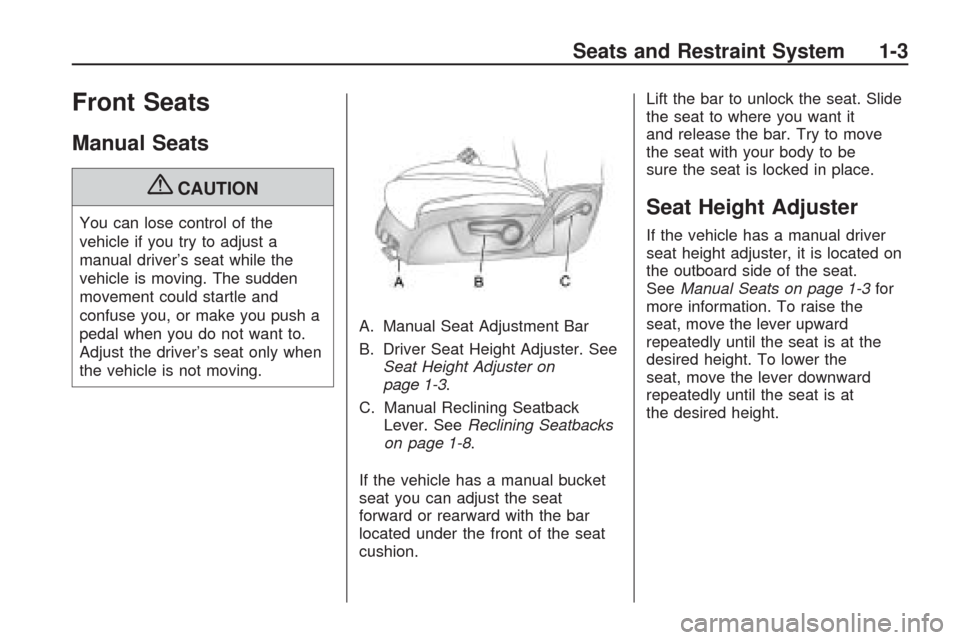
Front Seats
Manual Seats
{CAUTION
You can lose control of the
vehicle if you try to adjust a
manual driver’s seat while the
vehicle is moving. The sudden
movement could startle and
confuse you, or make you push a
pedal when you do not want to.
Adjust the driver’s seat only when
the vehicle is not moving.A. Manual Seat Adjustment Bar
B. Driver Seat Height Adjuster. See
Seat Height Adjuster on
page 1-3.
C. Manual Reclining Seatback
Lever. SeeReclining Seatbacks
on page 1-8.
If the vehicle has a manual bucket
seat you can adjust the seat
forward or rearward with the bar
located under the front of the seat
cushion.Lift the bar to unlock the seat. Slide
the seat to where you want it
and release the bar. Try to move
the seat with your body to be
sure the seat is locked in place.Seat Height Adjuster
If the vehicle has a manual driver
seat height adjuster, it is located on
the outboard side of the seat.
SeeManual Seats on page 1-3for
more information. To raise the
seat, move the lever upward
repeatedly until the seat is at the
desired height. To lower the
seat, move the lever downward
repeatedly until the seat is at
the desired height.
Seats and Restraint System 1-3
Page 8 of 422
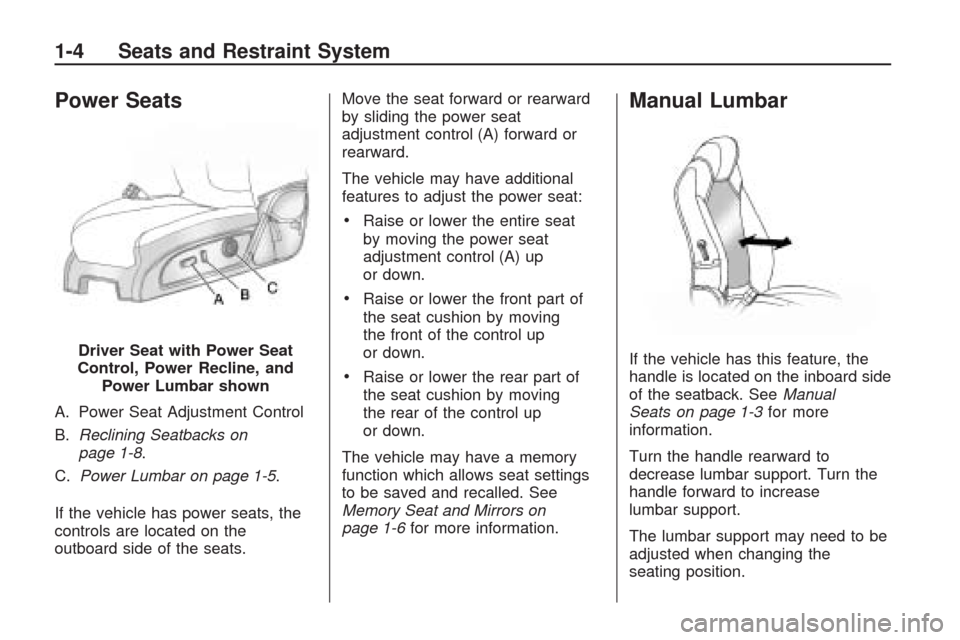
Power Seats
A. Power Seat Adjustment Control
B.Reclining Seatbacks on
page 1-8.
C.Power Lumbar on page 1-5.
If the vehicle has power seats, the
controls are located on the
outboard side of the seats.Move the seat forward or rearward
by sliding the power seat
adjustment control (A) forward or
rearward.
The vehicle may have additional
features to adjust the power seat:
Raise or lower the entire seat
by moving the power seat
adjustment control (A) up
or down.
Raise or lower the front part of
the seat cushion by moving
the front of the control up
or down.
Raise or lower the rear part of
the seat cushion by moving
the rear of the control up
or down.
The vehicle may have a memory
function which allows seat settings
to be saved and recalled. See
Memory Seat and Mirrors on
page 1-6for more information.
Manual Lumbar
If the vehicle has this feature, the
handle is located on the inboard side
of the seatback. SeeManual
Seats on page 1-3for more
information.
Turn the handle rearward to
decrease lumbar support. Turn the
handle forward to increase
lumbar support.
The lumbar support may need to be
adjusted when changing the
seating position. Driver Seat with Power Seat
Control, Power Recline, and
Power Lumbar shown
1-4 Seats and Restraint System
Page 9 of 422

Power Lumbar
If the seats have power lumbar, the
controls used to operate this
feature are located on the outboard
side of the seats. See “Power
Lumbar” underPower Seats on
page 1-4for more information.
To increase or decrease lumbar
support, press and hold the front
or rear of the control (C).
Release the control when the
seatback reaches the desired level
of lumbar support.
The lumbar support may need to
be adjusted when changing
the seating position.
Heated Seats
On vehicles with heated front seats,
the controls are located on the center
console. To operate the heated seats
the engine must be running.
I(Heated Seatback):Press to
turn on the heated seatback.
J(Heated Seat and Seatback):
Press to turn on or off the heated
seat and seatback.
The light on the button will come
on to indicate that the feature is on.
Each time the button is pressed, the
temperature settings change from
high, to medium, to low, to off.
Indicator lights above the button
will show the level of heat
selected: three for high, two
for medium, and one for low.
The passenger seat may take longer
to heat up.
If the vehicle has remote vehicle
start and is started using the remote
keyless entry transmitter, the front
heated seats will be turned on to the
high setting if it is cold outside.See “Remote Vehicle Start” under
Remote Keyless Entry (RKE)
System Operation on page 2-4.
When the ignition is turned on, the
heated seat feature will turn off.
To turn the heated seat feature back
on, press the desired button.Heated and Cooled Seats
If the front seats have the heated
and cooled seat feature, the buttons
used to control this feature are
located on the front doors near
the door handle.
H(Cooled Seat):To cool the
entire seat, press the button with
the cooled seat symbol.
This symbol will appear on the
climate control display to indicate
that the feature is on. Press the
button to cycle through the
temperature settings of high,
medium, and low and to turn the
cooled seat off. Indicator bars next
to the symbol designate the level of
cooling selected: three for high, two
for medium, and one for low.
Seats and Restraint System 1-5
Page 10 of 422
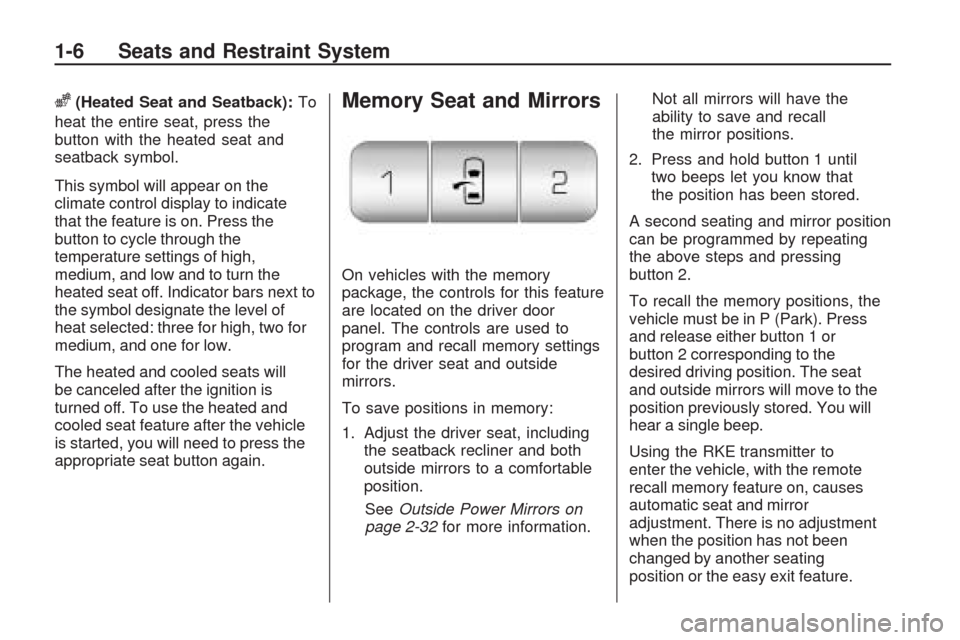
z(Heated Seat and Seatback):To
heat the entire seat, press the
button with the heated seat and
seatback symbol.
This symbol will appear on the
climate control display to indicate
that the feature is on. Press the
button to cycle through the
temperature settings of high,
medium, and low and to turn the
heated seat off. Indicator bars next to
the symbol designate the level of
heat selected: three for high, two for
medium, and one for low.
The heated and cooled seats will
be canceled after the ignition is
turned off. To use the heated and
cooled seat feature after the vehicle
is started, you will need to press the
appropriate seat button again.Memory Seat and Mirrors
On vehicles with the memory
package, the controls for this feature
are located on the driver door
panel. The controls are used to
program and recall memory settings
for the driver seat and outside
mirrors.
To save positions in memory:
1. Adjust the driver seat, including
the seatback recliner and both
outside mirrors to a comfortable
position.
SeeOutside Power Mirrors on
page 2-32for more information.Not all mirrors will have the
ability to save and recall
the mirror positions.
2. Press and hold button 1 until
two beeps let you know that
the position has been stored.
A second seating and mirror position
can be programmed by repeating
the above steps and pressing
button 2.
To recall the memory positions, the
vehicle must be in P (Park). Press
and release either button 1 or
button 2 corresponding to the
desired driving position. The seat
and outside mirrors will move to the
position previously stored. You will
hear a single beep.
Using the RKE transmitter to
enter the vehicle, with the remote
recall memory feature on, causes
automatic seat and mirror
adjustment. There is no adjustment
when the position has not been
changed by another seating
position or the easy exit feature.
1-6 Seats and Restraint System